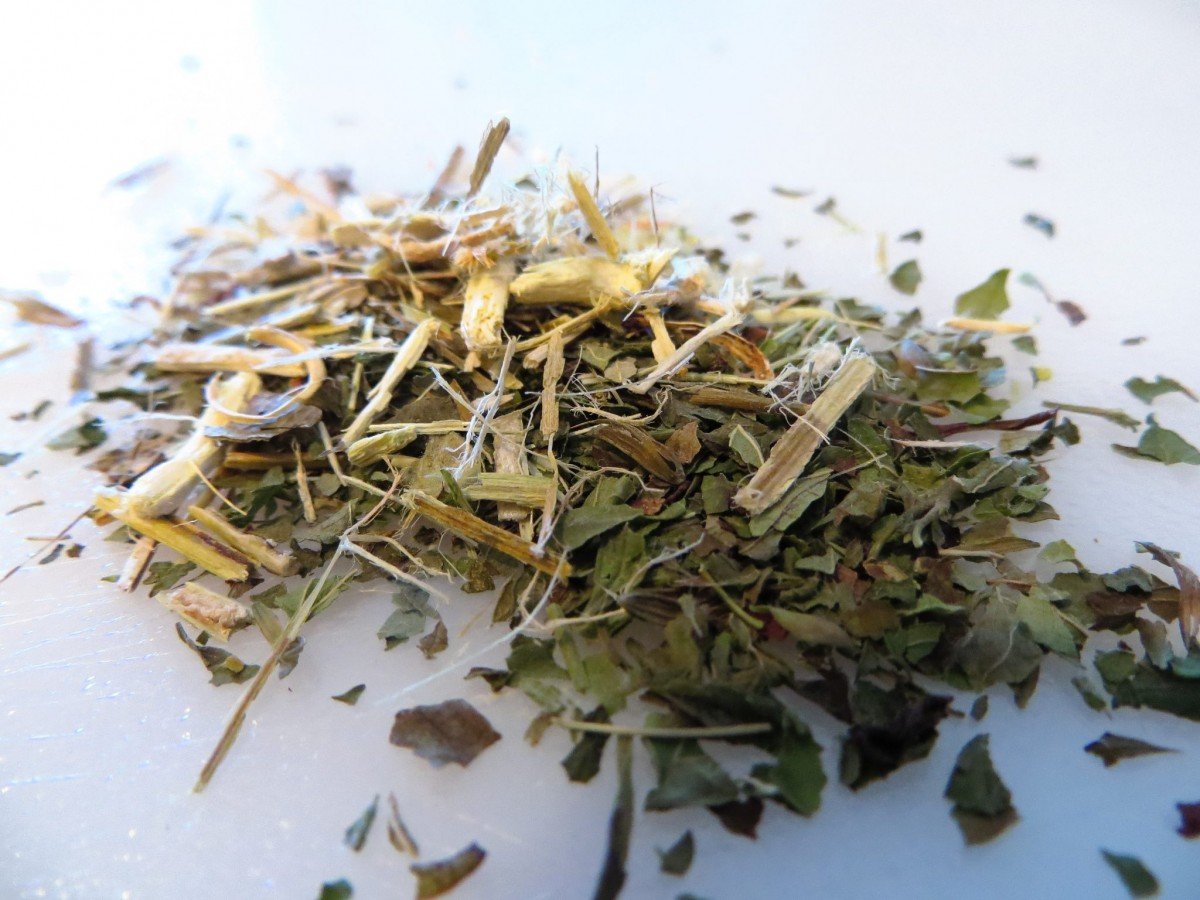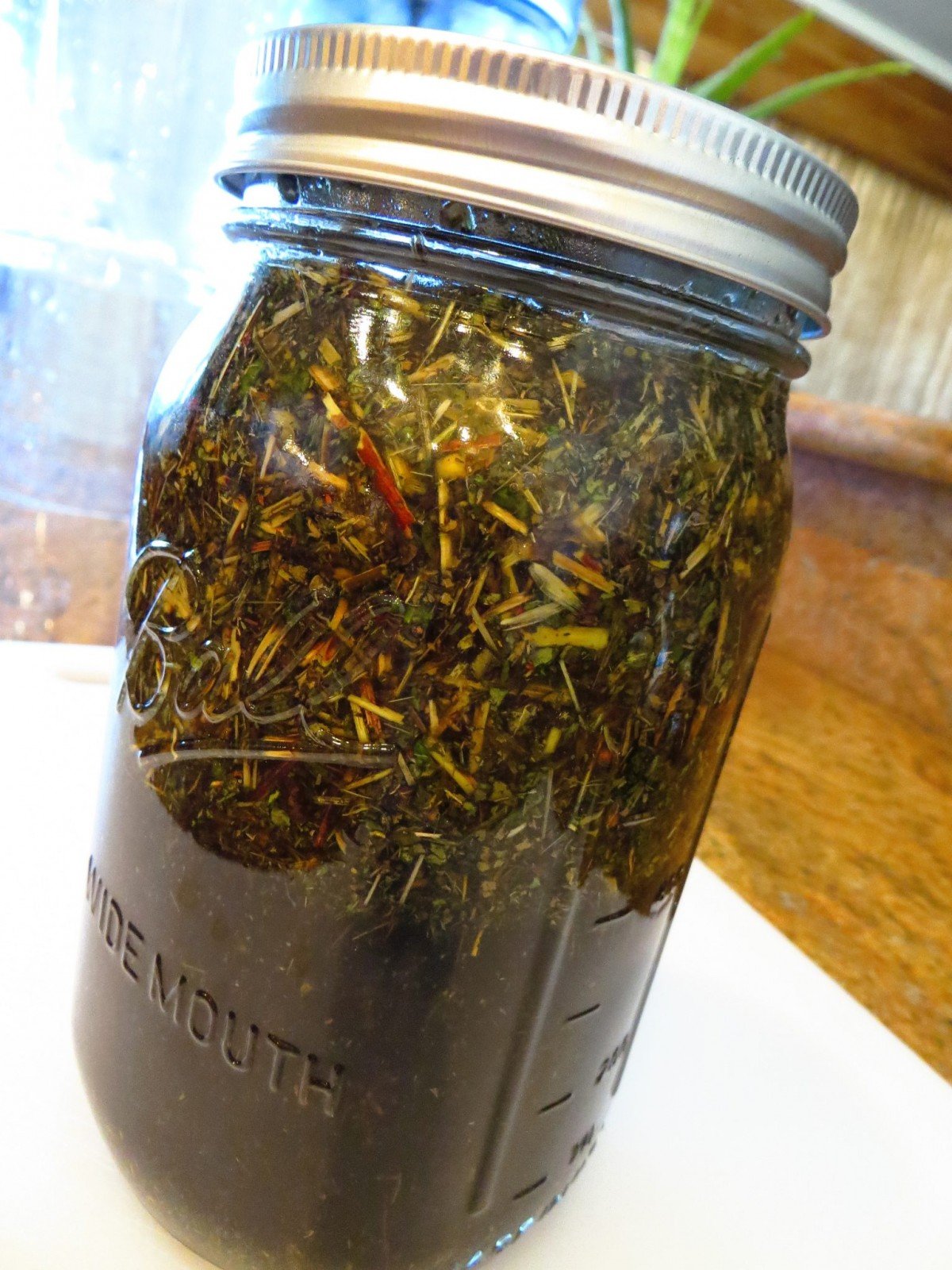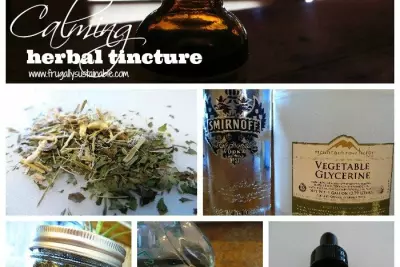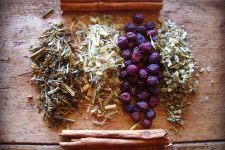The brain and nervous system hold all of the major communication pathways in the human body.
Nearly every disorder known to man has some root in this system.
Stress.
Chronic Fatigue.
Anxiety.
Hyperactivity.
Insomnia.
Migraines.
The effects of today’s fast-paced lifestyle have taken its toll.
Nervine Herbs
According to Philip Fritchey, in his book Practical Herbalism: Ordinary Plants with Extraordinary Powers, “nervines are herbs that support the health of the nervous system. They are used to relieve pain and regulate the nerve response.”
Nervines are divided into three classes…sedative, building, and stimulants.
When using these supporting herbs in the making of plant-based medicine — for the purposes of calming the nervous system — it is most beneficial to choose those herbs that are classified as sedative and building.
Because I wanted an easy-to-use remedy…I chose the extraction method.
And created a Calming Herbal Tincture.



Calming Herbal Tincture Recipe
Ingredients
*Herbs used in this recipe are organically-grown and dried.
- 2 cups 100 proof vodka
- 2 cups vegetable glycerin
- 2 parts lemon balm
- 2 parts catnip
- 1 part skullcap
- 1 part passionflower
- 1 part oatstraw
- 1/4 part hop flowers
Method
- Measure the herbs by parts, filling a quart-sized jar no more than a 1/3 full.
- Pour vodka and vegetable glycerin over the herbs until the liquid fills the jar, covering the plant material completely. Note: Use nothing but food-grade vegetable glycerin for tincturing (I always get Organic Vegetable Glycerin here from Mountain Rose Herbs).
- Stir well to combine. Then place a lid on the jar and shake.
- The jar should rest in a warm place, steeping near a sunny window, and it should be shook at least once daily (twice is best).
- Leave for steeping for 2-6 weeks.
- Pass tincture through a cheesecloth lined fine mesh sieve. Reserve liquid and compost plant material.
- Keep the strained tincture in a dark colored glass bottle or clear glass in a cool, dark place.
- Label each bottle with the name, date, and contents.
- Solutions prepared in this manner should keep — when properly stored — for 3-5 years.
To Use
Take 1-3 dropperfuls just before bed or any time calming is needed. Especially useful after stressful/highly emotional events.
Notes
-Some people like to use only glycerine or only alcohol when preparing tinctures. Each solvent abstracts different properties from the plants that the other method may not be as successful in…that is why both are used in this recipe. However, choose the solvent that best suits your needs and use that.
-For added sedative effects add 1/2 part of valerian root.
-In our home, everyone — all ages — takes this tincture as needed without any ill effects. Note: There is some question on the use of skullcap on children under 6 and pregnant and nursing mothers…so I would absolutely recommend that you either ask a professional healthcare provider or do your own research and decide for yourself.
Where Can I Get This Stuff?
–Mountain Rose Herbs…they have everything you’ll need for this remedy! I LOVE the quality of their dried herbs, oils, and essential oils. Including strictly medicinal, non-GMO herbal seeds for your home herb garden. It’s your one-stop-shop!
–The Bulk Herb Store also carries a few of these ingredients if you’d like to price check.
Thank you for your support and love for high-quality handcrafted natural products!




 How to Make Carrot Oil for Naturally Healthy Hair and Skin
How to Make Carrot Oil for Naturally Healthy Hair and Skin
Hi
Is there a subsititute for alcohol?
I am not fond of the vodka either, however, that would be key in calming nerves. I would be inclined to make a tea out of the herbs listed and see if that makes a difference.
If you do not wish to use any alcohol substitute the vodka with extra glycerine to make a glycetract instead of a tincture. Very similar medicinal effects but no alcohol.
You got it Jon! Use 4 cups of vegetable glycerin instead of half vodka and half glycerin.
You have to keep it refridgerated . Glycerine Tinctures do not keep as well.
Try making a tea with the same herbs
Unfortunately there is no substitute for the alcohol. I am not an alcohol user either, except for making tinctures. It will extract the medicinal properties out of the plant material. Glycerin will not get nearly as much of the medicinal properties out as alcohol. Since we are using drops at a time, not a glass full, it is not going to harm the body. Our bodies actually produce their own alcohol in minor amounts. Tinctures are safe to use, even for children and pets.
Hello, I’m a little late with my reply !! I do make my own tinctures as well and was tought that alcohol is volatile, thereore putting the tincture in a glass of water for 5 min. will take care of the alcohol and you’ll consume the beneficial plant extracts.
Hi can I omit the Vodka? is there something else I can replace it with like Valerian? Thank You
Use vegetable glycerin instead.
I don’t see anything wrong w/ the alcohol, it’s not bad. If you go to the herbal stores& purchase a Tincture it has alcohol in it. 99.8% of the time that’s what gets used because alcohol is the most effective at drawing out the important healing properties of the herbs.
I am curious if this would be effective if used on a regular bases. My husband has nerve twitches while he is sleeping all the time. I am looking for something he could do before bed daily to help his body relax more?
Yes it can be used regularly and I really believe it would be a wonderful remedy for your husband to try daily just prior to bedtime!
How do you use this tincture? rubbing it on a part of the body? or take a spoonful?
Thank you,
Inneke
Tinctures are one of the safest methods of healing the body there is. They can generally be used on a long term basis repeatedly throughout the day without any issues to be concerned of. We are using drops instead of cups full. Tinctures can be safely used for infants, children, elderly and people with sicknesses and health issues. Even some medical doctors, today, will tell you, that they are safe to use. Now, why has it taken so long for them to recognize a good thing? I wish we knew.
Coconut oil and broccoli darling, either one in the morning and then the other in the evening. Steam the broccoli well in purified water. All of that twitching will stop once his body receives the nutrition to enable him to build cells and overcome that. May all be well <3
The coconut oil eaten raw, and then the broccoli a lil bit later will help his nerves and muscles and so on to build well and sync <3
More likely your husband’s night time twitching is due to magnesium deficiency. It is very common for Americans to be deficient. Run a search on line. Same treatment for “restless leg syndrome”.
Is Vodka the only type of alcohol used in tincturing herbs? I believe Bach’s Rescue Remedy has brandy in it, or am I wrong?
Brandy makes a wonderful tincture! Use it in this recipe if it’s what you have on hand 🙂
Are the herb measurements by weight or volume?
Great question…I measure them in parts by volume.
Is there a reason why you don’t add chamomile?
Chamomile would be a wonderful addition! Take care however, it can cause an allergic reaction for those that have sensitivities to ragweed.
How much is a part please, one cup, 2 cups or how many grams? If one cup is 250 gram that makes 1 liter of fluid and 2 + kg of herbs. I don’t have a container big enough to steep or store all that lot.
Using parts as a unit of measure is referred to as the Simpler’s Measurement. The “part” is whatever unit of measure you want it to be…you simply apply it consistently throughout the ingredients. For example, if you decide in the case of this recipe to define “part” as tablespoon, you would use 2 tablespoons lemon balm and catnip; 1 tablespoon skullcap, passionflower, oatstraw; and 1/4 tablespoon hop flowers. If you wanted to make a larger batch, you could use an ounce (measured with a kitchen scale) as your definition of “part.” The Simpler’s Method isn’t always exactly perfect…but it’s perfect enough to make wonderfully potent herbal products 🙂
I’d like to know how much “1 part” is also, haha.
The alcohol extracts the medicine from the herbs, my suggestion if you do not want to consume the vodka when you take the medicine is to put the dropperfuls of tincture in a small cup of hot water and the alcohol will evaporate leaving the medicine in the water.
Actually you can make tinctures with water. But they have to be kept refrigerated and will last only 3 months in the fridge.
The alcohol is half the magic, alcohol is quickly absorbed into the bloodstream. This method means that the herb is in your system just minutes after dosing. It also raises the percentage of the amount of herb absorbed than other methods such as tea or tinctures with non-alcoholic liquids.
Many recovering alcoholics take tinctures without it opening the floodgates and setting the recovering alcoholic off on a binge. It is not like having a drink of Vodka it’s more like taking medicine, but follow your instincts I’m merely posting my opinion and do not wish to influence anyone into making a bad decision. Peace.
This is the first time I’ve seen vodka and glycerine used in combination (but I’m pretty new to all this). I know each can pull constituents that the other can’t, but I’m curious how these two blend?
I was wondering something, the recipe calls for “parts” –can you elaborate? Thanks!
Hi Jessica,
In any formula “parts” mean a particular measurement used for all ingredients. such as, 3 parts lavender, 2 parts tea tree, 1 part peppermint, the “part” could be 1 teaspoon or 1 cup, which ever you use. So let’s say, teaspoons are used it would be teaspoon in place of the word part, if a tablespoon was used, then replace “parts” for tablespoons, or cups, etc.
Good question! When we are used to making formulas, we don’t think about others who are new or not experienced in this reading for the first time, or those who just have not ever heard of the terms.
I have anxiety attacks really bad at times…what would be good for those? I don’t want to take Xanax. I am also afraid to try herbal stuff because of an allergic reaction. I am allergic to almost all antibiotics and sulfa drugs…so you can see why I am afraid to try new things. What are the risks associated with herbs, tinctures, etc? I have heard there is less of a chance of having any bad side effects to herbs verses man made medicines. I am sorry for asking such crazy questions but i have to err on the side of caution. Thank you.